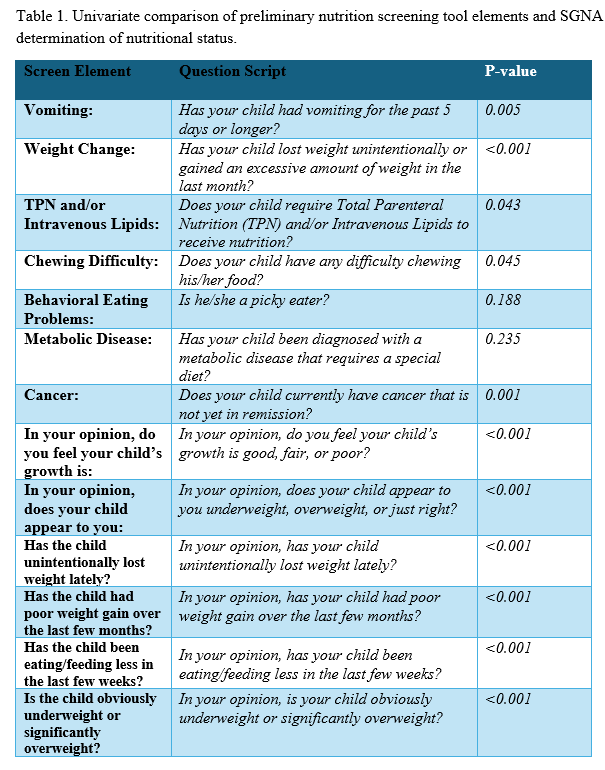Pediatric Nutrition
Session: Pediatric Nutrition
745 - Validation of a Nutrition Screening Tool in Critically Ill Children
Saturday, April 26, 2025
2:30pm - 4:45pm HST
Publication Number: 745.7037
Anna K. Burneske, Medical College of Wisconsin, Wauwatosa, WI, United States; Collin Ellenbecker, University of Wisconsin School of Medicine and Public Health, Madison, WI, United States; Evelyn M. Kuhn, Children's Wisconsin, Milwaukee, WI, United States; Scott A. Hagen, University of Wisconsin School of Medicine and Public Health, Madison, WI, United States; Matthew J.. Oelstrom, Marshfield Children's Hospital, Marshfield, WI, United States; Jennifer Peterson, Gundersen Lutheran Medical Center, Phoenix, AZ, United States; Charlene Pringle, University of Florida, Gainesville, FL, United States; Elizabeth Zivick, Medical University of South Carolina College of Medicine, Charleston, SC, United States; Megan Foxe, Shawn Jenkins Children's Hospital, Johns Island, SC, United States; Abigail Hebron, Shawn Jenkins Childrens Hospital, Summerville, SC, United States; Lynne Sears, American Family Children's Hospital, Madison, WI, United States; Sarah Mandli, American Family Children's Hospital, Madison, WI, United States; Sadaf U. Shad, Medical College of Wisconsin, Milwaukee, WI, United States; Nicole Fabus, Children's Hospital of Wisconsin, Milwaukee, WI, United States; Theresa Mikhailov, Medical College of Wisconsin, Milwaukee, WI, United States

Anna K. Burneske (she/her/hers)
Medical Student
Medical College of Wisconsin
Wauwatosa, Wisconsin, United States
Presenting Author(s)
Background: Malnutrition is prevalent among patients in the pediatric intensive care unit (PICU) and has been shown to worsen in some patients during the PICU stay. In critically ill children, malnutrition is associated with longer PICU length of stay and increased mortality.
The benefits of early enteral nutrition are well recognized; however, early intervention requires identification through a screening process. Several tools have been developed and validated to screen for nutritional status in children, but none were specifically designed for critically ill children. Our study aims to fill this gap.
In Phase I of this study, we developed a preliminary nutrition screening tool at Children’s Hospital of Wisconsin. In Phase II, we tested the preliminary tool in a larger population from six PICUs across the United States.
Objective: The goal of Phase II was to identify and validate the elements of the preliminary screening tool that most accurately indicated malnutrition.
Design/Methods: Each enrolled subject underwent the preliminary nutrition screen and a Subjective Global Nutritional Assessment (SGNA). The SGNA has been validated in critically ill children and was performed by a dietitian or trained provider. We considered the SGNA to be the gold standard for this analysis. We used chi-square tests and Mann-Whitney tests as appropriate to compare elements of the preliminary nutrition screen to the SGNA determination of nutritional status to identify those elements most associated with malnutrition. We used logistic regression analysis to determine the best fitting model of a malnutrition screening tool for critically ill children.
Results: We enrolled 732 subjects at six PICUs. Of these, 131 subjects (17.9%) were malnourished as determined by the SGNA. The children with malnutrition did not differ from the children without malnutrition with respect to age, sex, or race. Several elements of the preliminary nutrition screen were associated with malnutrition (see Table 1). The likelihood of malnutrition increased as weight-for-age percentile decreased (p < 0.001). We found that the best fitting model of a malnutrition screening tool for critically ill children included weight-for-age percentile and four elements of the preliminary nutrition screening tool (see Table 2).
Conclusion(s): We have developed and validated a nutrition screening tool for critically ill children that incorporates weight-for-age percentile and four additional elements that can be obtained through questions asked of the parent or guardian at admission to the PICU.
Table 1. Univariate comparison of preliminary nutrition screening tool elements and SGNA determination of nutritional status.

Table 2. Best fitting model of a malnutrition screening tool for critically ill children based on multivariate logistic regression analysis.
.png)

